
6 minute read
First Flowers
Primroses So much to love!
Iam so happy to be with all of you again. Between many phone calls, FaceTime, writing, working on a quilt, learning to weave, and then redoing some of the gardens, I have been quite busy. And now I am teaching online using Zoom and Webex. But I do miss human contact!
CAROL ANN HARLOS
Do you grow primroses in your gardens? You must grow them, even if you may have room for only one or two! These middle- to late-spring bloomers are such a welcome sight, and rabbits and deer don't seem to pay attention to them.
True primroses belong to the family Primulaceae. Don't confuse them with native evening primroses, which belong to an unrelated plant family. Evening primroses are naturalized throughout much of North America. True primroses were imported from all over the world including Europe, Tibet, and Western Africa.
Back to our garden (true) primroses. They are not really “prim” but “prime” meaning that they are among the first spring flowers to bloom. The commonest primroses are called Primulus vulgaris which means they are a common (“vulgaris” means common not vulgar!) plant that blooms early. There are several types that bloom all season long if it doesn't get too hot and dry. I grow them under trees, which keeps them out of the hot summer sun but enables the primroses to receive spring sun before the trees have leafed out.
There are several types of primroses. I love the candelabra primroses (Primula beesiana) as well as the common primroses. Whorls of flowers are carried on strong upright stems. They are very hardy and often bloom from spring into summer. Cut off the spent blossoms, give them some compost and some moisture, and you will be rewarded with a long season of bloom.
Primroses are some of the first flowers to bloom. Photos by Carol Ann Harlos

You can let some of the flowers go to seed, by the way, and after a few years, you will have a nice clump of flowers. I have had them seem to disappear for a year or two and suddenly there they are again. From seedlings, perhaps.
Then there are the alpine auricula primroses, Primula auricula. These come in many colors. The flowers look like clusters of little ears. ( I read somewhere that the ears resemble those of bears that live near the Tatras mountains!)
Double primroses make people ask, “What are those plants?” The flowers look so much like small roses and, to me, they smell fragrant. They also come in many colors. These primroses tend to disappear from my garden after a few years. I believe they are simply a short-lived perennial much like my beloved lupines.
A COMMUNITY OF CARING
FREE Wifi
Beauty salon Affordable Independent Living Walk-in showers Emergency pull cords Huge amount of activities Beautiful City Gardens Stay fit dining program w/ balanced
hot meals 5 days a week!

On Site Parking Secure Building


Spectacular Patio
New Heated Sidewalks! Avoid Falls!


Allioni’s primrose is a very early spring flowering plant. The flowers cover up the leaves. You can recognize them because the center of each flower usually is white.
Giant cowslip is a large, tall primrose growing up to several feet. The flowers are in umbels (like an umbrella). The base of each flower looks silvery. These didn't show up this year.
Primroses are pollinated by many different insects—I have seen bumblebees on the flowers. Such a pretty sight!
The seeds of primroses are spread by ants who take the seeds to the nest. The ant larvae eat a part that is attached to the seeds. Then the ants move the seed itself to their “garbage dump” where the seeds germinate. Voila! More primroses.
I understand that the leaves of primroses are edible. They can also be used to make tea (properly called a tisane), but I have tried neither the leaves nor the tisane. Better safe than sorry, I say!
This year, I sent away for some primrose seeds. I sprinkled the tiny seeds on top of moistened seed starter mix. They are presently very tiny plants. I will need to harden them off before placing them in the garden. I hope they overwinter well and successfully grow into new plants. I will place metal garden cloches over them, so I don't accidentally disturb them during the growing season and when they, hopefully, emerge next spring. (I also placed the cloches over the lupines as they died down last autumn so I would avoid damaging them as they re-emerged this spring. I had grown some lupines from seed, and they were still so tiny in the autumn.) It's a good thing to protect them, as it is so easy to uproot young plants in the spring. FY
I so look forward to hearing from you again and thank those of you who took the time to send email questions and comments during our hiatus. Email me at caharlos@verizon.net.

The sweet flowers come in many colors and shapes and thrive in shady spots.
410 Mill Street, Williamsville 716.632.3000 www.park-creek.com


Stimulating social, educational,
& recreational activities
Medication Management Access to 24-hour personal care
assistance
Affordable Memory care program
“Embrace seasons past... begin life anew!”


NOW OFFERING ENHANCED ASSISTED LIVING AND RESPITE CARE
Ask about our 12th Anniversary Move-In Special
RETIREMENT AGE SENIORS SCARED OVER COVID-19 VIRUS
Many retirement age seniors have voiced serious concerns over the COVID-19 layoff s, which they were told would be temporary. Unfortunately, many are now realizing they will be permanently without employment as the future of many businesses remains uncertain.
Losing employment has sparked a signifi cant increase in incentivized early retirement which has forced transition from Employer Health Insurance to signing up for Medicare Health Insurance, but trouble occurs when Erie County Senior Services, Social Security and County Senior Centers are all locked and closed, off ering no resources or assistance to help.
As a 501(c)3 nonprofi t, the WNY Medicare Resource Center does not follow county mandates and remains open to assist in qualifying and signing up for Medicare Part B, assisting in coordination with employer HR departments and off ers on-site Medicare Insurance Services with representation from ALL COMPANIES in one convenient location to compare plans objectively.
NEW TO MEDICARE CHECKLIST:
1. Complete CMS Form 40B-E and submit 90 days prior to your 65 th birthday 2. Complete CMS Form L564E to avoid federal
LEP penalty 3. Drive around town and collect brochures from every company in WNY off ering Medicare
Insurance 4. Confi dently understand the diff erence between Part A, Part B, Part C and Part D – also the diff erence between HMO, PPO, PFFS,
POS and Medigap plans 5. Confi dently choose a Medicare Insurance plan before the Initial IEP deadline



